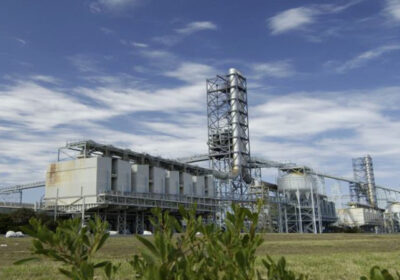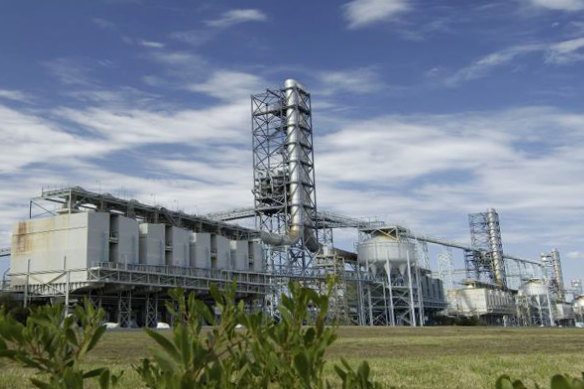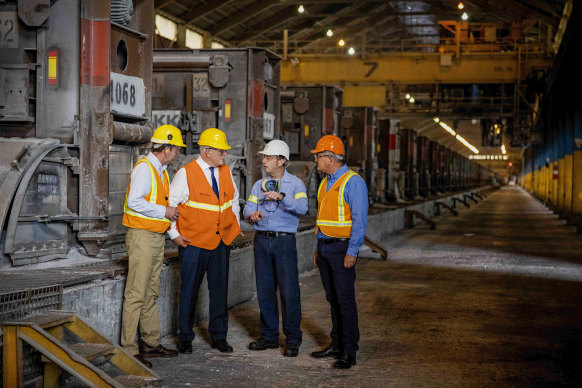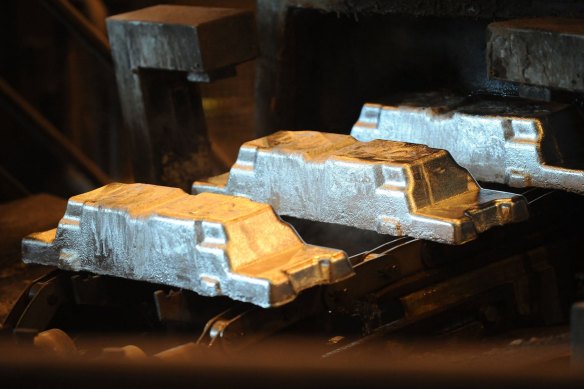Power play: Portland smelter future, jobs secured with new electricity deal

Save articles for later
Add articles to your saved list and come back to them any time.
Key points
- Alcoa and AGL have struck a new deal to power the Portland aluminium smelter.
- The deal will provide 50 per cent of the smelter’s power needs until 2035.
- Environment Victoria wants the plan to be 100 per cent reliant on renewables faster.
Aluminium giant Alcoa has struck a nine-year deal to secure 50 per cent of the electricity required for its smelter in far south-west Victoria, which locks in 760 jobs in the region.
The Portland smelter is one of the state’s biggest electricity users and Alcoa says it produces about 20 per cent of Australia’s aluminium. Both AGL and Alcoa released statements on Friday morning saying the deal would help secure the local jobs.
The Portland aluminium smelter in Victoria’s south-west.
The new agreement, which will deliver 300 megawatts of power supply, will begin in July 2026. The smelter can produce 358,000 tonnes of aluminium annually and is currently working at 75 per cent of that capacity.
Alcoa reported that 40 per cent of the smelter’s electricity consumption currently comes from renewable sources, and the company is working towards a goal of net-zero carbon emissions by 2050. However, it is unclear how much power will come from renewables under the nine-year deal that expires in 2035.
Ian Tulloch, an adjunct research fellow in politics at La Trobe University, said successive prime ministers and premiers had sought to ensure Alcoa continued operating its Portland smelter out of fear of losing the jobs.
“It’s always been about jobs in that part of the state,” he said. “But it comes at an enormous cost.”
Then-prime minister Scott Morrison and then-trade minister Dan Tehan (left) at the Portland smelter in 2021 with Alcoa executives Ron Jorgensen and Michael Gollschewski.Credit: Alcoa Australia
Both state and federal governments have offered many millions of dollars in funding and subsidies to keep the smelter operating in Portland.
Tulloch said protecting jobs was critical for both sides of politics.
“Economically, I don’t think it’s justifiable to spend that much money, but it’s become politically impossible to back away now,” he said.
In 2021, then-prime minister Scott Morrison flew into Portland to announce a five-year energy deal for the smelter with a commitment of $76.8 million.
The future of Alcoa’s Portland smelter has been secured until 2035.Credit: Joe Armao
Morrison’s visit came four years after predecessor Malcolm Turnbull also went to Portland and delivered $30 million to keep the plant operating following a power cut that resulted in molten alumina “freezing” in pots.
The Victorian government has never publicly disclosed the value of subsidies it has provided to keep Alcoa’s aluminium smelter running.
The smelter is thought to account for about 10 per cent of Victoria’s electricity demand.
AGL was unable to tell The Age how much renewable energy would be provided under the nine-year agreement. But the company cited its portfolio of generation, which includes wind, solar and hydro-generated electricity. It also operates the Loy Yang A coal-fired power station in the Latrobe Valley.
Alcoa Australia president Matt Reed said his company was “pursuing options” for the smelter’s remaining electricity needs after 2026. But he insisted there would be a strong focus on renewable energy.
“South-western Victoria has been identified as a renewable energy zone with several emerging projects that could potentially provide green power to the smelter and the wider region,” he said.
AGL chief executive Damien Nicks said the agreement ensured the Portland smelter could continue providing stability to Victoria’s energy network, as well as valuable exports for the economy.
In a statement, Australian Workers Union Victorian branch secretary Ronnie Hayden said the deal guaranteed stable employment and fostered confidence among union members.
“This agreement strategically positions the smelter as a vital access point for numerous upcoming local renewable projects aiming to contribute their power to the grid,” he said.
Environment Victoria chief executive Jono La Nauze welcomed the agreement to keep the smelter running, but said the companies needed to move faster towards having the operation 100 per cent reliant on renewable power.
“There is no room in the future economy for aluminium produced with dirty energy,” he said. “We do want to see the smelter stay open. We think producing green aluminium in Victoria is a terrific opportunity.”
Get the day’s breaking news, entertainment ideas and a long read to enjoy. Sign up to receive our Evening Edition newsletter here.
Most Viewed in National
From our partners
Source: Read Full Article


